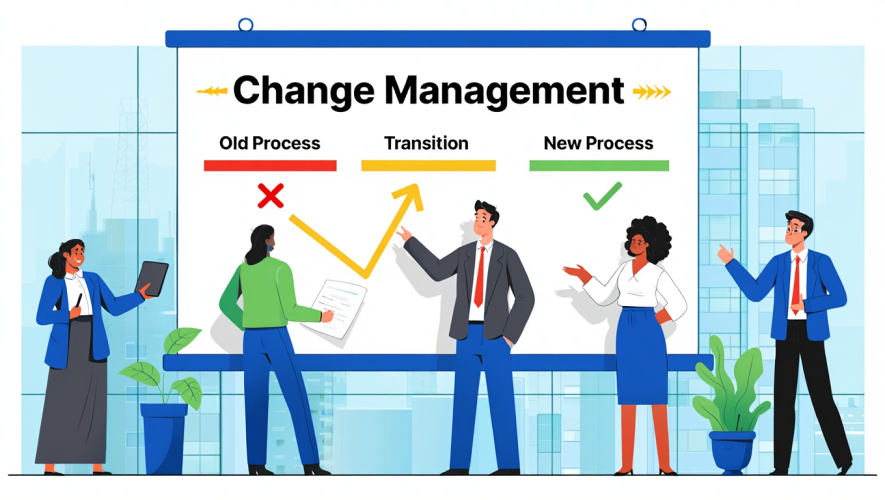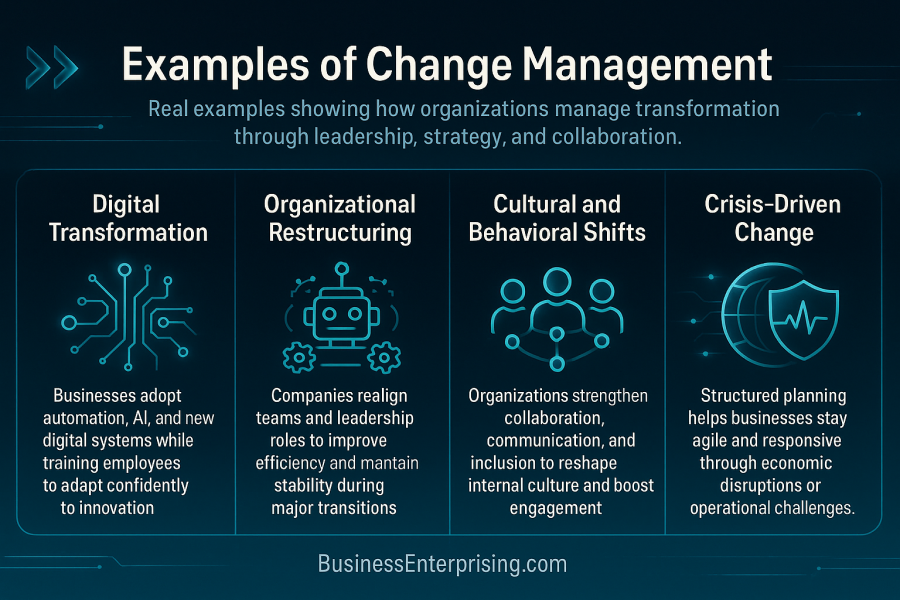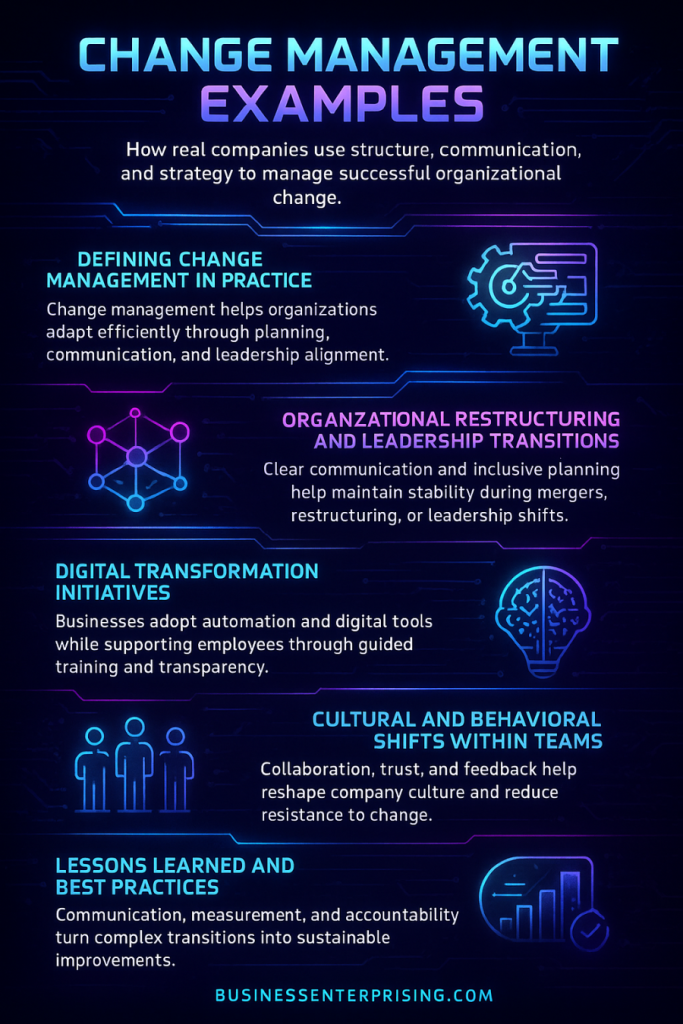
Additionally, change management focuses on people as much as on process. You must prepare employees to accept and support new directions. When your team feels informed and included, resistance decreases, and engagement grows. This alignment helps maintain productivity while introducing new systems or strategies. Leadership plays an essential role in building trust and keeping everyone focused on shared goals. Therefore, change management becomes a collaborative effort that strengthens both culture and performance.
Moreover, every organization benefits from learning how others approached similar challenges. By studying proven approaches, you can identify what works and what causes friction. These lessons reveal that successful change requires structure, empathy, and accountability. Regular communication, training, and feedback keep momentum steady throughout transitions. Over time, this approach builds confidence and consistency across all levels of your organization.
Change management is not about control but about direction and clarity. You can guide transformation effectively when communication, leadership, and culture align. By applying tested strategies, your organization can adapt quickly without losing stability or focus. When managed with care and structure, change becomes an opportunity for improvement, innovation, and growth.
Defining Change Management in Practice
Change management refers to the structured process of helping an organization adapt to new conditions or strategies. It focuses on guiding people, systems, and operations through transition while reducing disruption. Every business experiences change, whether through technology upgrades, growth, or market shifts. How you manage that process determines whether your team moves forward with confidence or resistance. When handled well, change management builds trust and strengthens your organization’s long-term adaptability.
Additionally, successful change management relies on communication and clear planning. You need to explain the purpose, outline the steps, and provide consistent support. Employees respond better when they understand how change affects them and why it matters. Therefore, leadership plays a major role in setting the tone. When leaders show transparency and consistency, teams feel motivated to contribute to the new direction. This approach helps transform uncertainty into shared progress.
Moreover, studying real change management examples offers valuable insight. Practical cases show how different organizations approach transition, handle resistance, and achieve measurable results. These examples make the concept more relatable and easier to apply within your business. They reveal that successful change depends on people as much as on strategy. Each example highlights that preparation, empathy, and feedback drive sustainable outcomes.
When you understand change management as a practical discipline, you can guide your organization through transformation with clarity. By focusing on communication, structure, and accountability, you reduce confusion and increase engagement. Over time, these principles help your team build resilience and confidence. Change will always bring challenges, but a structured approach helps turn disruption into progress. Strong leadership and consistent action make lasting change achievable for every organization.
Organizational Restructuring and Leadership Transitions
Organizational restructuring and leadership transitions are among the most significant challenges a business can face. These shifts affect how teams communicate, operate, and perform. You might encounter them during mergers, acquisitions, or leadership succession. The goal during these transitions is to maintain clarity, confidence, and connection among employees. When handled thoughtfully, they strengthen your company’s foundation instead of disrupting it.
Additionally, effective leadership transitions rely on transparent communication and consistent support. Employees should understand what changes are happening and how those changes will influence their roles. Therefore, leaders must provide direction while remaining approachable. For example, companies that involve employees early in the process experience less anxiety and higher engagement. Structured communication, regular updates, and open dialogue create stability even when roles evolve.
Moreover, some of the strongest change management examples come from businesses that balance structure with empathy. Mergers and departmental shifts often challenge company culture, yet many organizations manage these transitions with success. They invest in training programs, define new reporting structures, and clarify expectations. These efforts help employees align with the company’s new goals while maintaining morale. When people feel informed and valued, they adapt more easily to organizational change.
Your leadership approach defines how smoothly transitions unfold. By emphasizing trust, clarity, and consistency, you create a culture that welcomes change rather than resists it. Thoughtful restructuring not only improves operational efficiency but also strengthens your team’s resilience. Over time, each successful transition builds momentum and confidence for future shifts. When you prioritize communication and engagement, restructuring becomes a process of renewal, not disruption.
Digital Transformation Initiatives
Digital transformation has reshaped how businesses operate and connect with customers. Organizations now use automation, cloud platforms, and digital tools to increase efficiency and competitiveness. You can see this shift in nearly every industry, where manual systems give way to smarter, data-driven processes. However, technology alone does not guarantee success. People must adapt, learn, and feel confident using new tools to achieve meaningful progress.
Additionally, strong leadership drives successful transformation. Leaders must communicate why digital change matters and how it benefits both the organization and employees. When employees understand the purpose behind innovation, they embrace it more willingly. Therefore, training and open discussion become essential parts of the process. Many companies create structured learning programs that help teams adjust without fear or confusion. This approach reduces resistance and builds a sense of ownership among staff.
Moreover, practical change management examples show how clear planning and support make digital adoption smoother. Some businesses introduce automation gradually, while others redesign entire systems at once. Both methods require communication, testing, and continuous feedback. By involving employees early, you reduce disruption and improve long-term results. When people feel heard and supported, technology becomes an opportunity rather than an obstacle.
Digital transformation continues to shape how organizations grow and compete. The most successful efforts combine modern technology with thoughtful change leadership. You can strengthen your company’s digital strategy by prioritizing training, transparency, and collaboration. Over time, these actions lead to higher productivity, greater innovation, and stronger employee engagement. Transformation is less about replacing systems and more about aligning technology with human progress.
Cultural and Behavioral Shifts Within Teams
Cultural and behavioral change within teams requires patience, consistency, and strong leadership. When you shift workplace culture, you influence how people think, act, and collaborate. Many organizations face resistance when introducing new ideas or processes. Employees often feel uncertain about expectations or the impact of change. Therefore, communication and alignment become key to creating lasting behavioral transformation.
Additionally, companies that reshape culture focus on shared values and clear goals. Leadership sets the example by modeling the behaviors they want to see. When employees witness genuine commitment from management, they respond with trust and engagement. Regular meetings, open discussions, and recognition programs help reinforce these shifts. Over time, consistent action replaces old habits with new standards that align with company objectives.
Moreover, successful change management examples show that culture evolves through inclusion, not direction. Businesses that involve employees in shaping new norms experience stronger buy-in and faster results. For example, organizations that prioritize feedback create environments where teams feel respected and motivated to contribute. These efforts reduce tension and promote collaboration across departments. When everyone feels heard, resistance fades, and cooperation becomes natural.
Cultural change is not about rewriting values but about living them through daily behavior. You can strengthen your organization by focusing on communication, accountability, and continuous learning. Behavioral alignment improves performance, morale, and customer satisfaction. By promoting openness and adaptability, you create a culture ready for growth and innovation. Long-term success depends on how well your team embraces change and works together toward shared purpose.
Crisis-Driven Change and Business Continuity
Crisis-driven change often forces organizations to adapt quickly and think strategically under pressure. Events such as economic downturns, global pandemics, or supply chain disruptions test every aspect of business operations. You may face uncertainty in staffing, logistics, and customer demand all at once. However, companies that use structured change frameworks manage these disruptions with greater control and resilience. These methods focus on planning, communication, and collaboration rather than reaction.
Additionally, strong leadership becomes the anchor during a crisis. Leaders who communicate clearly and act decisively help stabilize teams and maintain confidence. Many organizations have adjusted operations by introducing remote work systems, new digital processes, or revised production strategies. Therefore, flexibility and transparency play a key role in sustaining momentum. By setting short-term priorities and providing consistent updates, companies can reduce confusion and support employee morale.
Moreover, many effective change management examples come from businesses that treated crisis as a chance to innovate. Some shifted to digital platforms, others diversified supply chains, and many developed cross-functional teams to solve emerging problems. These actions kept operations running and often revealed new revenue opportunities. When change is guided by structure instead of panic, recovery becomes faster and more sustainable. Employees adapt better when they understand both the challenge and the plan for overcoming it.
Crisis-driven change builds long-term resilience when handled with structure and empathy. You can strengthen your organization by anticipating disruption and preparing flexible systems that adapt quickly. Every crisis exposes weaknesses, but it also highlights the value of leadership, communication, and teamwork. By learning from these moments, your company becomes stronger, more adaptable, and better prepared for whatever comes next.
Lessons Learned and Best Practices for Implementation
Successful change depends on how well leadership communicates, employees engage, and results are tracked. Change management works best when everyone understands the purpose behind it. Clear communication helps align goals, set expectations, and reduce confusion. You can guide your team more effectively when you explain not only what is changing but also why it matters. When employees feel informed, they are more likely to support the process and contribute to success.
Additionally, strong change management examples show that collaboration drives better outcomes. When people are involved early, they adapt faster and contribute valuable feedback. Open discussion builds trust and allows concerns to surface before they become obstacles. Therefore, creating channels for two-way communication helps maintain transparency. Leaders who listen and respond to feedback gain respect and commitment from their teams. A culture of cooperation keeps the process smooth and productive.
Moreover, measuring progress helps you identify what works and where to adjust. Tracking performance indicators such as productivity, engagement, or satisfaction provides clear insights. These metrics transform change from an abstract concept into tangible progress. Over time, measurable results build confidence and demonstrate accountability. This approach keeps everyone focused on shared goals and long-term improvement.
Change management succeeds through structure, communication, and follow-through. You can lead your organization effectively by balancing planning with flexibility. Each experience teaches lessons that prepare you for the next transition. Strong leadership, active participation, and continuous measurement create a framework for lasting progress. By applying these principles consistently, you build a culture that adapts with confidence and grows through every transformation.
Conclusion
Change management continues to shape how businesses grow, adapt, and respond to challenges. Every transition offers lessons about leadership, communication, and employee engagement. You can see through real change management examples that success depends on preparation, empathy, and structure. When companies treat change as a shared effort rather than a directive, they build trust and long-term resilience. Therefore, managing transformation with intention benefits both performance and culture.
Additionally, effective change management connects strategy to people. Your ability to lead through uncertainty defines how your organization evolves. Clear communication reduces confusion, while collaboration keeps teams aligned. When employees understand their role in change, they act with confidence. This alignment strengthens productivity and preserves morale during times of transition. Over time, these practices create an adaptable culture that views change as progress rather than disruption.
Moreover, reflection after each transformation improves future performance. Measuring results, gathering feedback, and acknowledging success reinforce accountability and growth. Structured evaluation also helps identify what worked well and what needs adjustment. Therefore, continuous learning turns each project into a foundation for improvement. Consistency in this process builds credibility and strengthens leadership influence across the organization.
Sustaining progress requires a mindset of adaptability and communication. You can guide your team through complex transitions with honesty, structure, and shared purpose. When you approach change with planning and patience, you transform challenges into new opportunities. By focusing on collaboration and clarity, your organization becomes more resilient, innovative, and prepared for whatever comes next.



